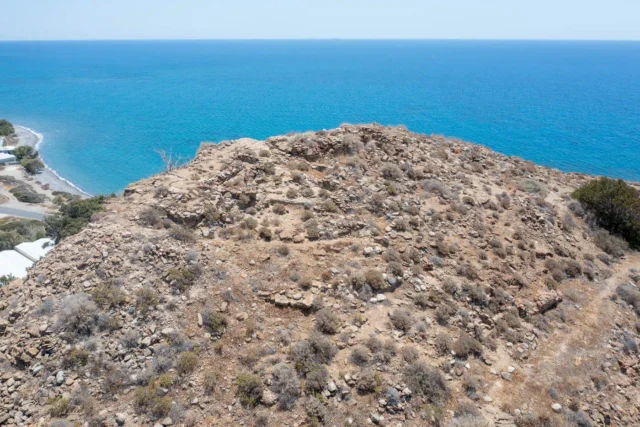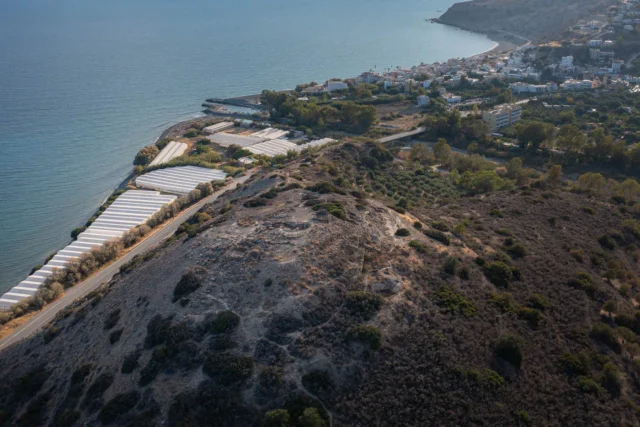26
listings found
Categories
Active filters:
Oreino, Ierapetra
Oreino, or Orno, is a mountain village in Ierapetra, eastern Crete, at 620m altitude on Mount Afentis. First mentioned in 1368, it's known for the 5km long Oreino Gorge with the Byzantine Transfiguration of the Savior church. The village, once on Kastri peak, is now verdant with pine trees near Lake Skafi and the Red Butterfly Gorge. The gorge's name comes from its red butterfly population, impacted by a 1993 fire. Oreino is accessible from Ierapetra and offers traditional Cretan cuisine at the "Orno" tavern. The settlement's history includes Venetian and Ottoman rule, reflected in its architecture and cultural heritage.
Pacheia Ammos, Ierapetra
Pachia Ammos, a coastal village in Lasithi, Crete, is situated near the archaeological sites of ancient Minoa and Gournia. The village, mentioned by Basilicata in 1630, developed in the 20th century, becoming a tourist center. It boasts a long beach, taverns, and the Institute for the Study of Prehistoric Aegean Eastern Crete. The village's name, meaning "thick sand," reflects its beach. Pachia Ammos is served by bus routes connecting it to nearby cities and has a rural medical center, schools, and various shops. The area's history includes the Minoan civilization, with Gournia being a significant site. The current population is around 574 inhabitants.
Vasiliki, Ierapetra
Vasiliki, a village in Ierapetra, Lasithi, Crete, is known for its significant Minoan settlement dating from the Early Minoan II to the Late Minoan I periods (2600-1550 BC). The settlement, located on Kastelli hill, prospered due to its location on the Ierapetra isthmus and the surrounding fertile plain, near Gournia. Excavations by Harriet Boyd, Richard Seager, and Antonis Zois revealed Vasiliki-style pottery and confirmed Mycenaean fortification and aqueduct presence. The village's history includes mentions in the 1671 Turkish census, the 1834 Egyptian census, and subsequent population records. The settlement's central building was destroyed by fire around 2300 BC, but later reoccupation occurred, with Roman-era traces also found.
Ierapetra, Ierapetra
Ierapetra (Ιεράπετρα) is a coastal city located on the southeastern coast of Crete, Greece. It is the largest town in the regional unit of Lasithi and the fourth largest in […]
Fournou Koryfi
Fournou Korifi, an Early Minoan settlement near Myrtos village in Crete, dating back to the mid-3rd millennium BCE, provides valuable insights into the Minoan civilization. The settlement, with approximately 90 rooms during its peak, features the "Myrtos Goddess" figurine and evidence of workshops and diverse economic activities. Archaeologists, including Peter Warren, have studied the site's social structures, with interpretations ranging from communal living to a more complex hierarchy. The South House offers a glimpse into domestic life with its weaving room and kitchen. Fournou Korifi's well-preserved remains contribute to our understanding of Early Minoan architecture, social organization, and daily life.
Myrtos archaeological site
The Myrtos-Pyrgos archaeological site, also known as Pyrgos, is a significant Minoan Bronze Age settlement located on the southern coast of Crete, near Ierapetra. Occupied from the Early Minoan II to the Late Minoan IB period, it provides valuable insights into the development of the Minoan civilization. The site's strategic location and long occupation history make it a key resource for understanding the social, economic, and political dynamics of this ancient society. Excavations have revealed a variety of artifacts, including seals, seal impressions, Linear A tablets, and inscriptions on clay vessels, shedding light on the evolution of communication, administrative practices, and trade networks in Minoan Crete. The site's chronological phases, from Pyrgos I to Pyrgos IV, show a growing cultural sophistication and connections with other parts of Crete, including Malia and Knossos. The final phase, Pyrgos IV, ended with a catastrophic fire that destroyed much of the settlement, marking the end of its prominence.











